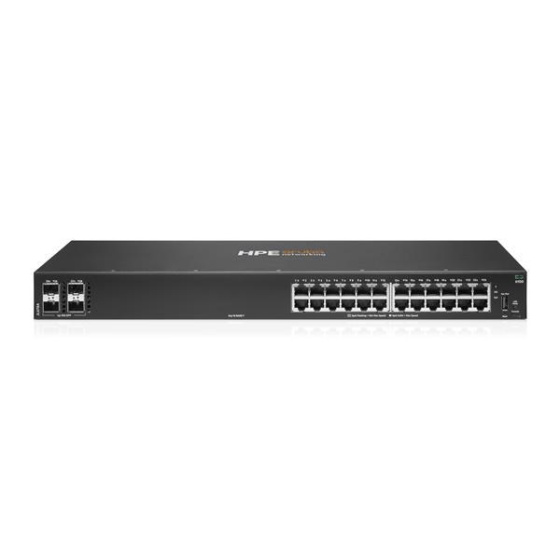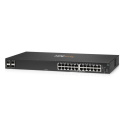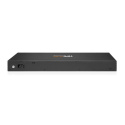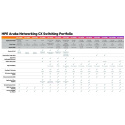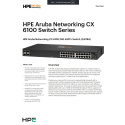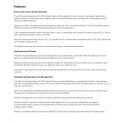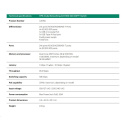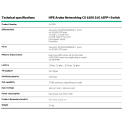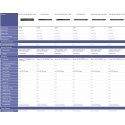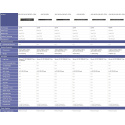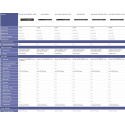HPE Aruba Networking CX 6100 24G 4SFP+ Switch JL678A RENEW
Kód: 1881136
| Feature | JL678A (24G 4SFP+) | |
|---|---|---|
| Ports | 24x 10/100/1000BASE-T, 4x 1G/10G SFP | |
| PoE Support | No | |
| Console Ports | 1x USB-C Console, 1x USB Type-A Host | |
| Power Supply | Fixed 65W | |
| Fans | Fixed fans (side-to-side airflow) | |
| Dimensions (H x W x D) | 4.39 x 44.2 x 20.12 cm | |
| Weight | 2.62 kg (5.78 lbs) | |
| CPU | Dual Core ARM Cortex A9 @ 1016 MHz | |
| Memory & Flash | 4 GB DDR3, 16 GB eMMC | |
| Packet Buffer | 12.38MB total (4.5MB ingress, 7.875MB egress) | |
| Switching Capacity | 128 Gbps | |
| Throughput Capacity | 95.2 Mpps | |
| Average Latency | 1 Gbps: 1.5 µs, 10 Gbps: 1.8 µs | |
| SVIs (Switched Virtual Interfaces) | 16 | |
| IPv4 Host Table (ARP) | 1,024 | |
| IPv6 Host Table (ND) | 512 | |
| IPv4/IPv6 Unicast Routes | 512 each | |
| MAC Table Capacity | 8,192 | |
| IGMP/MLD Groups | 512 each | |
| Ingress ACL Entries (IPv4/IPv6/MAC) | 256 / 128 / 256 | |
| Operating Temp | 0 to 45°C (derate above 1.5 km) | |
| Operating Humidity | 15% to 95% non-condensing | |
| Acoustic Noise | 20.9 dB | |
| Power Consumption (230 VAC) | Idle: 15.4W, Max (no PoE): 33W | |
| Current | 0.6A / 0.4A | |
| Mounting | 19-inch rack, |
HPE Aruba CX 6100 Series — Key Highlights
Target Use Case:
-
Designed for entry-level access switches ideal for enterprise branch offices and small-to-medium business (SMB) networks.
Purpose & Benefits:
-
Reliable, simple, and secure wired access.
-
Supports IoT, mobile, and cloud applications with wired connectivity.
Architecture & OS:
-
Built on HPE Aruba ASIC architecture for high performance.
-
Runs programmable AOS-CX OS, consistent across Aruba CX portfolio for easy, efficient management.
Features:
-
Fully managed Layer 2 switching.
-
High-speed uplinks available, with up to 370W PoE support (across the series) to power devices like security cameras and wireless APs.
-
Includes compact, fanless models — great for quiet office environments.
Management Flexibility:
-
Multiple management options:
-
Web GUI
-
Command Line Interface (CLI)
-
Cloud-based or on-premises management via HPE Aruba Central
-
-
Enables flexible deployment choices with no need for hardware replacement when management needs evolve.
Security & Performance:
-
Enhanced access security.
-
Traffic prioritization (QoS).
-
Full IPv6 support.
Ownership Advantages:
-
Switch software embedded with no subscription required — lowers ongoing costs.
-
Comes with a Limited Lifetime Warranty for peace of mind.
Standard Features & Product Differentiators
1. AOS-CX Operating System (Modern Software System)
-
Modular Linux-based OS, database-driven architecture
-
Easy access to all network state information
-
REST APIs for programmable network tasks
-
Microservices architecture for integration and resiliency
-
Near real-time state synchronization for software processes
2. HPE Aruba Networking ASICs (Programmable Innovation)
-
Over 30 years of ASIC innovation
-
Tight hardware-software integration for optimized performance and capacity
-
Low latency, increased buffering, adaptive power consumption
3. Management & Automation Tools
-
HPE Aruba Networking Central: Unified cloud/on-prem management for wired, WLAN, SD-WAN, public cloud
-
HPE Aruba Networking NetEdit: Automates switch configurations across network; centralized, validated, and audited management (license required)
4. Mobility and IoT Performance
-
Non-blocking bandwidth up to 176 Gbps; forwarding rates up to 98.6 Mpps
-
Selectable queue configurations for application-specific performance tuning
-
Supports Power over Ethernet (PoE) up to 370W (24-port) or 740W (48-port) models
-
Fanless, compact models available for quiet environments
5. Simplified Operations
-
Colorless ports with local user roles & local MAC authentication (LMA) for dynamic VLAN assignment
-
Auto-MDIX for cable type auto-detection
-
Support for Energy Efficient Ethernet (802.3az)
-
Support for pre-standard PoE devices
6. Enterprise-Class Connectivity
-
Fixed 1U models: 24 or 48 ports of 1GbE with 4 built-in 1GbE/10GbE uplinks
-
Jumbo frames support (up to 9198 bytes)
-
Packet storm protection (broadcast, multicast, unknown unicast)
-
Unsupported Transceiver Mode (UTM) support (no warranty on unsupported transceivers)
7. Resiliency & Availability
-
Uni-directional Link Detection (UDLD) to avoid loops
-
IEEE 802.3ad LACP support (8 LAGs, 8 links per LAG)
-
Multiple Spanning Tree Protocol (MSTP), Rapid Spanning Tree (RSTP), and legacy STP support
-
SmartLink for active/standby link redundancy
8. Quality of Service (QoS)
-
Strict Priority queuing
-
Traffic prioritization (IEEE 802.1p)
-
Class of Service (CoS) based on IP, TCP/UDP ports, DiffServ, etc.
-
Rate limiting on ingress and queue minimums
-
Large buffers for congestion management
9. Management Interfaces & Security
-
Web GUI, CLI, REST API, SNMP v1/v2c/v3 support
-
sFlow for wire-speed network monitoring
-
Secure management via SSHv2, SSL, SNMPv3
-
Multiple user privilege levels and access restrictions
-
Support for TFTP/SFTP configuration updates
-
Debugging utilities (ping, traceroute)
-
NTP support for consistent time sync
-
LLDP for network device discovery
-
Dual flash images and multiple config file support
-
UDLD for link health monitoring
10. Layer 2 Switching Features
-
VLAN support: 4094 VLAN IDs, 512 active VLANs
-
Jumbo packet support (up to 9220 bytes)
-
RPVST+, MSTP, RSTP, STP support
-
MVRP for VLAN learning and assignment
-
BPDU tunneling for transparent STP over WANs
-
Port mirroring (4 groups)
-
IGMP for multicast control
11. Layer 3 Features
-
Static IP routing for IPv4 and IPv6 (dual-stack support)
-
ARP with static ARPs
-
DNS client and server support
-
DHCP client and relay support (DHCPv4)
-
Loopback detection for network reliability
12. Multicast Support
-
IGMP snooping and MLD snooping for IPv6 multicast traffic management
-
Supports IGMP versions 1, 2, and 3
13. IPv6 Capabilities
-
IPv6 host management and dual-stack transition support
-
IPv6 ACL and QoS support
-
IPv6 static routing
-
Security features: RA guard, dynamic IPv6 lockdown, ND snooping
14. Security Features
-
Trusted Platform Module (TPM) integrated for boot integrity
-
Access Control Lists (ACLs) for IPv4/IPv6 with granular filtering
-
RADIUS and TACACS+ for authentication & authorization
-
Control Plane Policing (rate limiting for control protocols)
-
IEEE 802.1X client authentication, MAC authentication, web auth support
-
Secure CLI and GUI access (SSH, SSL, SNMPv3)
-
CPU protection against DoS attacks
-
ICMP throttling to mitigate DoS attacks
-
Identity-driven ACLs for user-based policies
-
STP BPDU port protection and root guard
-
Dynamic IP lockdown and ARP protection
-
DHCP snooping and relay protection
-
Port security, MAC address lockout, source-port filtering
-
Security banners and MAC pinning
15. Convergence and Power Management
-
LLDP-MED support for automatic QoS and VLAN config for IP phones
-
PoE power allocation via usage or class, with LLDP and LLDP-MED support
-
Auto VLAN for voice via RADIUS and LLDP-MED
Network Protocols and Services
-
DNS: RFC 1591 (client), RFC 3596 (DNS Extension for IPv6)
-
SSH: SSHv1/SSHv2, RFC 4251, 4252, 4253, 4254, 4419 (Key Exchange for SSH)
-
SNTP: RFC 4330 Simple Network Time Protocol v4
-
TFTP: RFC 783, RFC 1350 (revision 2)
-
BOOTP: RFC 951 (VLAN 1 only), RFC 1542 (BOOTP Extensions, VLAN 1 only)
-
DHCP: RFC 2131 DHCP client, RFC 3315 DHCPv6 (client only), DHCP relay support
-
ICMP: RFC 792, RFC 4443 (ICMPv6)
-
TCP/UDP: RFC 793 (TCP), RFC 768 (UDP), RFC 4113 (UDP MIB partially)
-
ARP: RFC 826 (Address Resolution Protocol)
-
IPv6: RFC 2460, RFC 3513 (Addressing Architecture), RFC 4861 (Neighbor Discovery), RFC 4862 (Stateless Auto-configuration), IPv6 static routing support
-
Path MTU Discovery: RFC 8201
-
Remote Operations (Ping): RFC 2925
-
Multicast: IGMPv2, IGMPv3, IGMP/MLD Snooping, Multicast Listener Discovery (MLD)
IEEE Network Standards
-
Layer 2 & VLAN:
-
IEEE 802.1D (MAC Bridges)
-
IEEE 802.1p (Priority)
-
IEEE 802.1Q (VLAN tagging, up to 4094 VLAN IDs)
-
IEEE 802.1s (Multiple Spanning Trees)
-
IEEE 802.1w (Rapid Spanning Tree)
-
IEEE 802.1AB (Link Layer Discovery Protocol - LLDP)
-
ANSI/TIA-1057 (LLDP-MED)
-
-
Ethernet and Physical Layer:
-
IEEE 802.3 (10BASE-T)
-
IEEE 802.3ab (1000BASE-T)
-
IEEE 802.3ad (Link Aggregation Control Protocol - LACP)
-
IEEE 802.3at (Power over Ethernet)
-
IEEE 802.3az (Energy Efficient Ethernet)
-
IEEE 802.3x (Flow Control)
-
-
Security & Access Control:
-
IEEE 802.1X (Port Based Network Access Control)
-
Management and Monitoring
-
SNMP:
-
RFC 1098 (Simple Network Management Protocol)
-
SNMPv1/v2c/v3 supported
-
RMON groups 1, 2, 3, and 9 (statistics, history, alarm, events) (RFC 2819)
-
MIB Support: RFC 1213, 1493, 2674 (partial), 2737, 2863, 4022 (TCP), 4293 (IP)
-
-
sFlow: RFC 3176
-
RADIUS and TACACS+:
-
RFC 2138 (RADIUS Authentication)
-
RFC 2866 (RADIUS Accounting)
-
RFC 1492 (TACACS+)
-
Quality of Service
-
DiffServ:
-
RFC 2474 (DiffServ precedence)
-
RFC 2475 (DiffServ architecture)
-
RFC 2597 (Assured Forwarding)
-
RFC 2598 (Expedited Forwarding)
-
Security and Encryption
-
SSL: Secure Sockets Layer for encrypted web access
-
SSH: Secure shell access with encryption
-
TACACS+ and RADIUS for secure authentication and authorization
HPE Aruba Networking CX 6100 24G 4SFP+ Switch
Product Number: JL678A
Key Differentiators
- 24 × 10/100/1000BASE-T Ports
- 4 × 1G/10G SFP Ports
- 1 × USB-C Console Port
- 1 × USB Type-A Host Port
- Fixed Power Supply
- Fixed Fans
Hardware Specifications
| Processor | Dual Core ARM Cortex A9 @ 1016 MHz |
|---|---|
| Memory | 4 GB DDR3 (maximum, depending on model) |
| Flash Storage | 16 GB eMMC |
| Latency | 1 Gbps: 1.5 µs, 10 Gbps: 1.8 µs |
| Throughput | 95.2 Mpps |
| Switching Capacity | 128 Gbps |
| PoE Capability | Up to 370W (depending on model) |
| Input Voltage | 100-127 VAC / 200-240 VAC |
| Power Consumption | Max Power (without PoE): 33W |
| Dimensions (H × W × D) | 4.4 × 44.2 × 20.1 cm |
| Weight | 2.6 kg |
.
, ,





